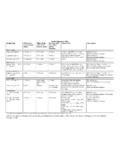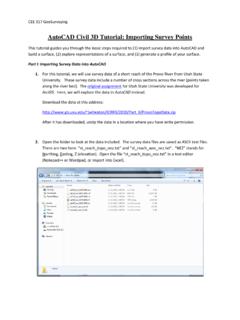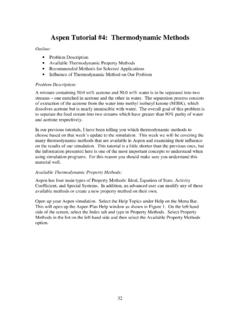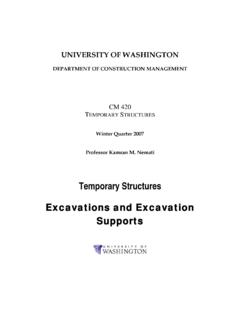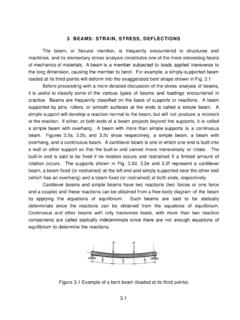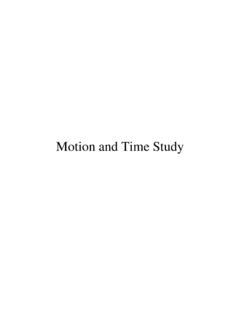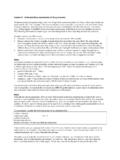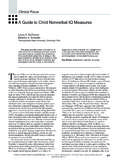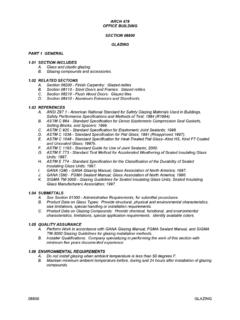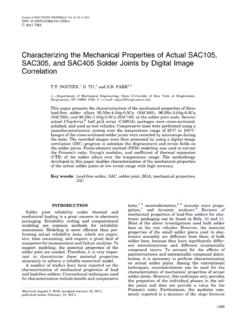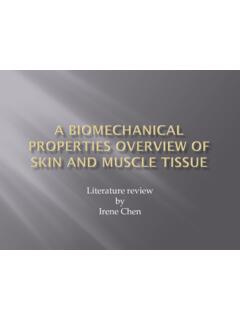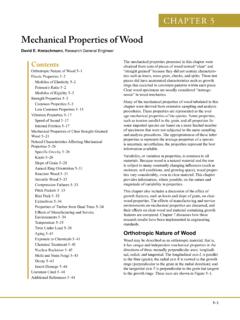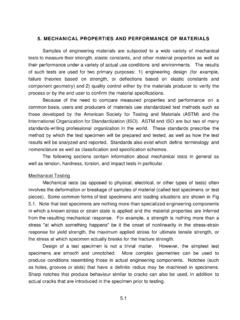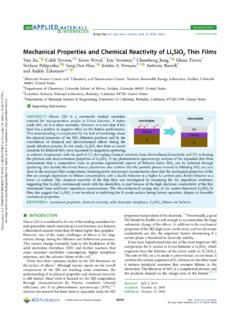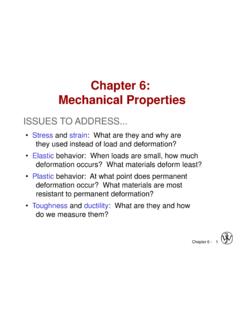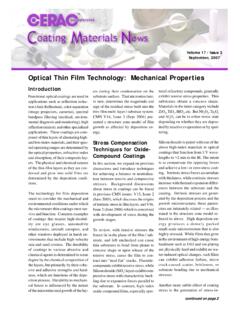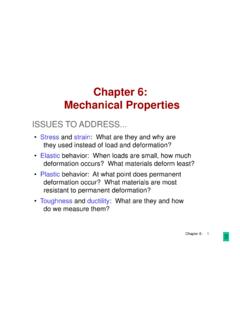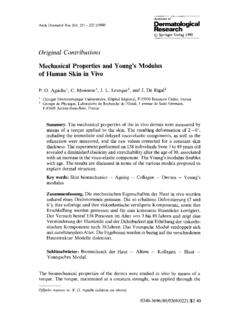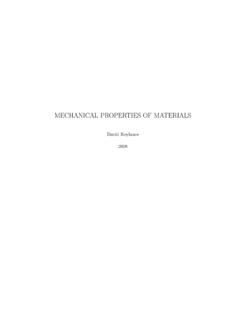Transcription of Mechanical Properties of Biological Tissues 15
1 Mechanical Properties of Biological ViscoelasticityThe material response discussed in the previous chapterswas limited to the response of elastic materials, in particularto linearly elastic materials. Most metals, for example,exhibit linearly elastic behavior when they are subjected torelatively low stresses at room temperature. They undergoplastic deformations at high stress levels. For an elasticmaterial, the relationship between stress and strain can beexpressed in the following general form:s s e :( )Equation ( ) states that the normal stresssis a func-tion of normal straineonly. The relationship between theshear stresstand shear straingcan be expressed in a similarmanner.
2 For a linearly elastic material, stress is linearlyproportional to strain, and in the case of normal stress andstrain, the constant of proportionality is the elastic modulusEof the material ( ):s Ee:( )While investigating the response of an elastic material, theconcept of time does not enter into the discussions. Elasticmaterials show time-independent material behavior. Elasticmaterials deform instantaneously when they are subjected toexternally applied loads. They resume their original(unstressed) shapes almost instantly when the applied loadsare is a different group of materials such as polymerplastics, almost all Biological materials, and metals at hightemperatures that exhibits gradual deformation and recov-ery when they are subjected to loading and response of such materials is dependent upon howquickly the load is applied or removed, the extent of defor-mation being dependent upon the rate at which the deforma-tion-causing loads are applied.
3 This time-dependent materialbehavior is calledviscoelasticity. Viscoelasticity is made upof two words: viscosity and a fluidproperty and is a measure of resistance to ,on the other hand, is a solid material property. Therefore,a viscoelastic material is one that possesses both fluid andsolid viscoelastic materials, the relationship between stressand strain can be expressed as:s s e;_e :( )Equation ( ) states that stress,s, is not only a functionof strain,e, but is also a function of thestrain rate,_e de=dt,wheretis time. A more general form of Eq. ( ) can beobtained by including higher order time derivatives of ( ) indicates that the stress strain diagram of aviscoelastic material is not unique but is dependent upon therate at which the strain is developed in the material( ).
4 Fig. elastic material behaviorN. O zkaya et al.,Fundamentals of Biomechanics: Equilibrium, Motion, and Deformation,DOI ,#Springer Science+Business Media, LLC 2012221!rrlleeddoouuxx@ Analogies Based on Springsand DashpotsIn , while covering Hooke s Law, an analogy wasmade between linearly elastic materials and linear elastic material deforms, stores potential energy, andrecovers deformations in a manner similar to that of a elastic modulusEfor a linearly elastic material relatesstresses and strains, whereas the constantkfor a linear springrelates applied forces and corresponding deformations( ). BothEandkare measures of stiffness. Thesimilarities between elastic materials and springs suggestthat springs can be used to represent elastic material behav-ior.
5 Since these similarities were first noted by RobertHooke, elastic materials are also known asHookean subjected to external loads, fluids deform as deform continuously, orflow. For fluids, stresses arenot dependent upon the strains but on the strain rates. If thestresses and strain rates in a fluid are linearly proportional,then the fluid is called alinearly viscous fluidor aNewtonianfluid. Examples of linearly viscous fluids include water andblood plasma. For a linearly viscous fluid,s _e :( )In Eq. ( ), (eta) is the constant of proportionalitybetween the stresssand the strain rate_e, and is called thecoefficient of viscosityof the fluid. As illustrated in ,the coefficient of viscosity is the slope of thes$_egraph of aNewtonian fluid.
6 The physical significance of this coefficientis similar to that of the coefficient of friction between thecontact surfaces of solid bodies. The higher the coefficientof viscosity, the thicker the fluid and the more difficult it isto deform. The coefficient of viscosity for water is about1 centipoise at room temperature, while it is about for blood spring is one of the two basic Mechanical elementsused to simulate the Mechanical behavior of materials. Thesecond basic Mechanical element is called thedashpot,which is used to simulate fluid behavior. As illustrated , a dashpot is a simple piston cylinder or a syringetype of arrangement. A force applied on the piston willadvance the piston in the direction of the applied speed of the piston is dependent upon the magnitudeof the applied force and the friction occurring between thecontact surfaces of the piston and cylinder.
7 For a lineardashpot, the applied force and speed (rate of displacement)are linearly proportional, thecoefficient of frictionm(mu)being the constant of proportionality. If the applied force andthe displacement are both in thexdirection, then,F m_x:( )Fig. between a linear spring and an elastic solidFig. strain rate diagram for a linearly viscous fluidFig. rate (_e) dependent viscoelastic behaviorFig. linear dashpot and its force displacement rate diagram22215 Mechanical Properties of Biological Tissues !rrlleeddoouuxx@ Eq. ( ),_x dx=dtis the time rate of change ofdisplacement or the comparing Eqs. ( ) and ( ), an analogy can bemade between linearly viscous fluids and linear stress and the strain rate for a linearly viscous fluid are,respectively, analogous to the force and the displacementrate for a dashpot; and the coefficient of viscosity is analo-gous to the coefficient of viscous friction for a analogies suggest that dashpots can be used to repre-sent fluid Empirical Models of ViscoelasticitySprings and dashpots constitute the building blocks of modelanalyses in viscoelasticity.
8 Springs and dashpots connectedto one another in various forms are used to construct empiri-cal viscoelastic models. Springs are used to account for theelastic solid behavior and dashpots are used to describe theviscous fluid behavior ( ). It is assumed that a con-stantly applied force (stress) produces a constant deformation(strain) in a spring and a constant rate of deformation (strainrate) in a dashpot. The deformation in a spring is completelyrecoverable upon release of applied forces, whereas thedeformation that the dashpot undergoes is Kelvin Voight ModelThe simplest forms of empirical models are obtained byconnecting a spring and a dashpot together in parallel andin series configurations.
9 As illustrated in , theKelvin Voight modelis a system consisting of a spring anda dashpot connected in a parallel arrangement. If subscripts s and d denote the spring and dashpot, respectively, thena stresssapplied to the entire system will produce stressesssandsdin the spring and the dashpot. The total stressapplied to the system will be shared by the spring and thedashpot such that:s ss sd:( )As the stresssis applied, the spring and dashpot willdeform by an equal amount because of their parallel arrange-ment. Therefore, the straineof the system will be equal tothe strainsesandedoccurring in the spring and the dashpot:e es ed:( )The stress strain relationship for the spring and thestress strain rate relationship for the dashpot are:ss Ees;( )sd _ed:( )Substituting Eqs.
10 ( ) and ( ) into Eq. ( ) willyield:s Ees _ed:( )From ( ),es ed e. Therefore,s Ee _e:( )Note that the strain rate_ecan alternatively be written asde=dt. Consequently,s Ee dedt:( )Equation ( ) relates stress to strain and the strain ratefor the Kelvin Voight model, which is a two-parameter(Eand ) viscoelastic model. Equation ( ) is anordi-nary differential equation. More specifically, it is a firstorder, linear ordinary differential equation. For a given stresss, Eq. ( ) can be solved for the corresponding prescribed straine, it can be solved for that the review of how to handle ordinary differen-tial equations is beyond the scope of this text. The interestedFig.

